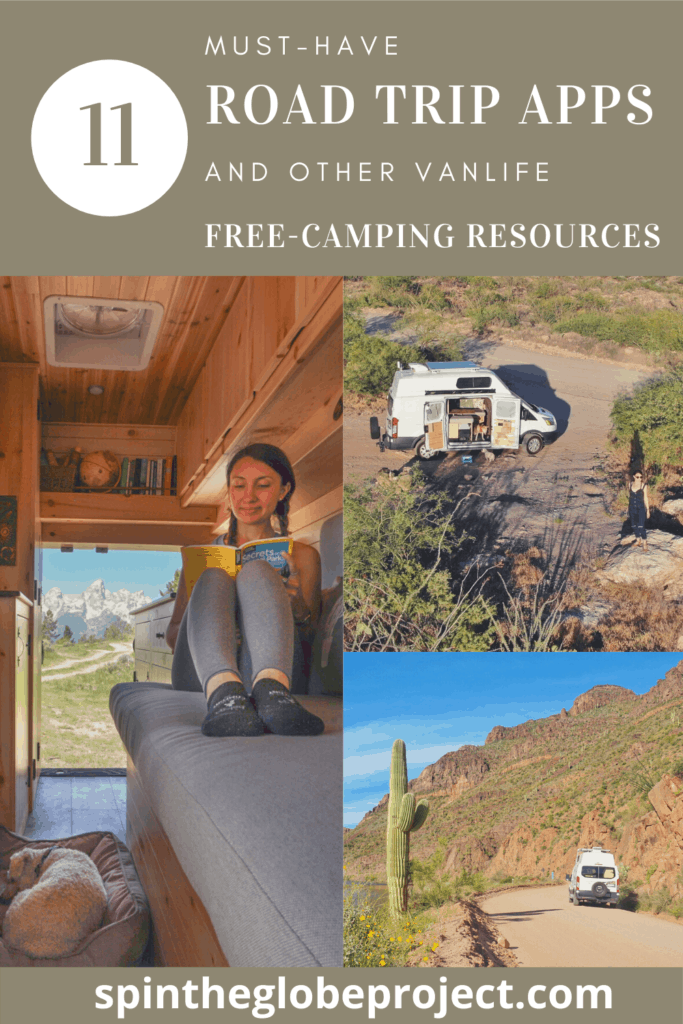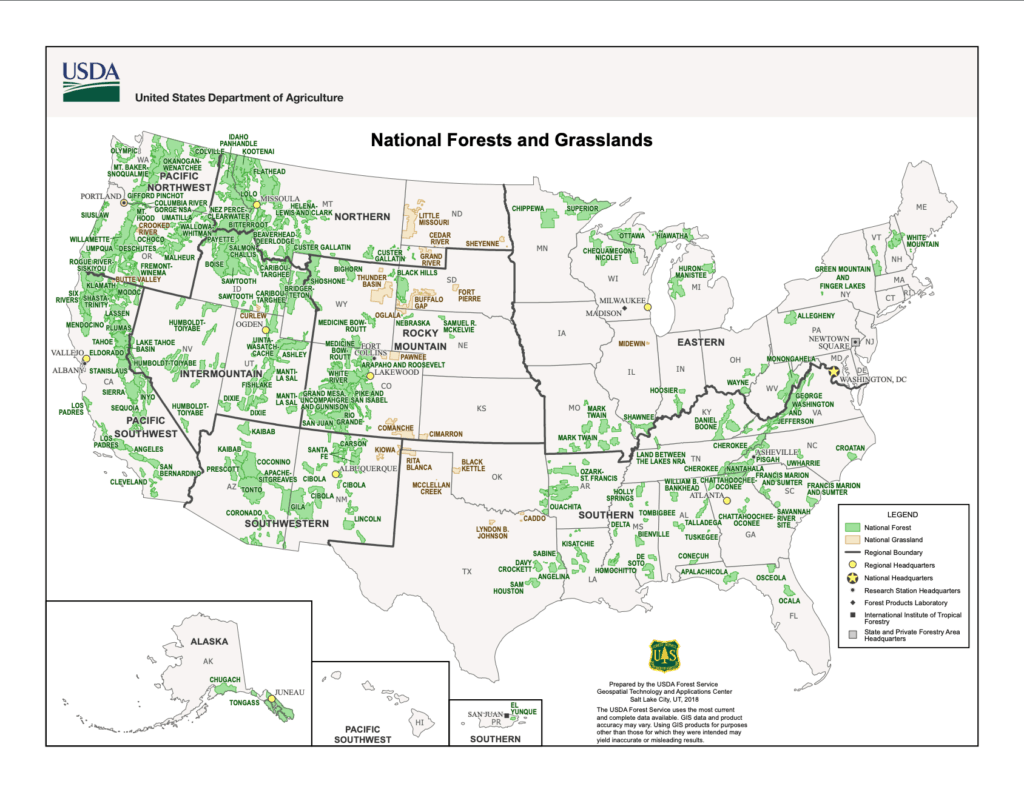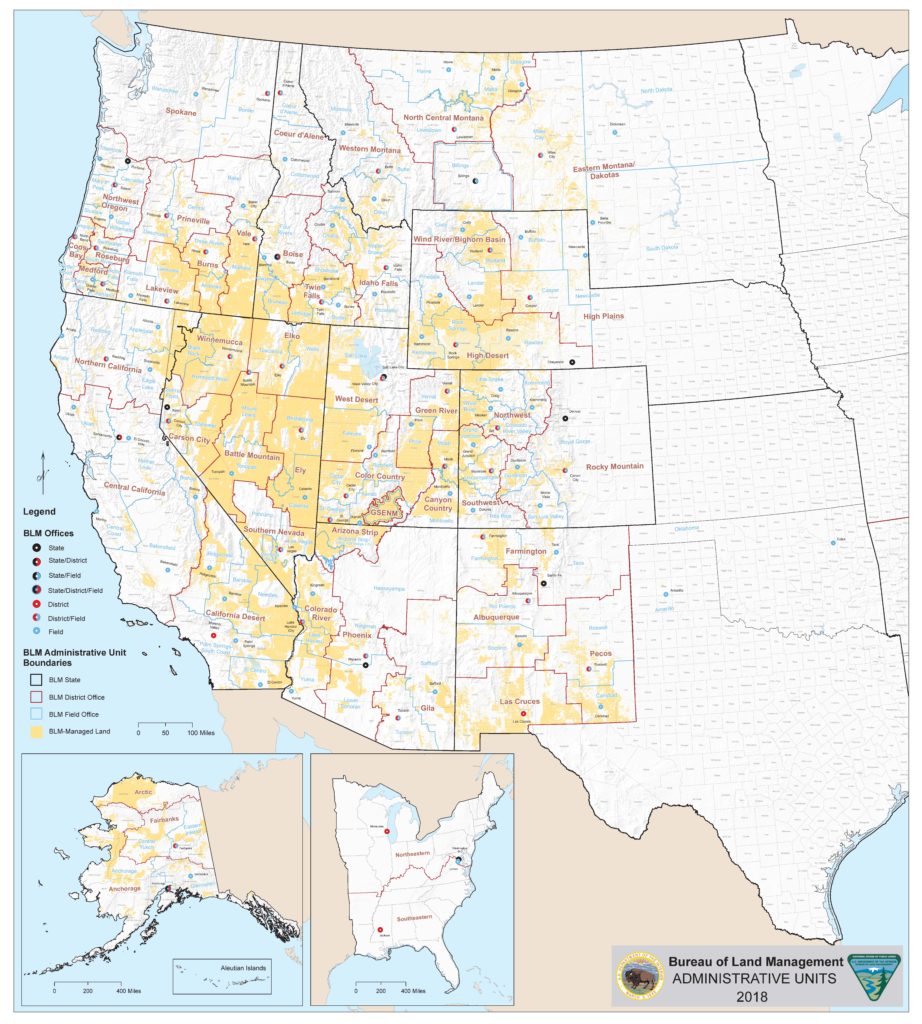
My number one cost of living reduction from full-time van-life came from eliminating rent, which was only possible thanks to free camping sites. From camping on public land to camper-friendly parking lots; this post includes all my tips and tricks for finding free camping spots while living and traveling on the road.
Whether you are just planning a short road trip, going car camping, or you are planning to live on the road full-time, this post will provide you with everything you need to know about finding free camping spots, with all the methods I have used while living on the road in my converted Ford Transit camper van for over a year full-time and 3 years part-time.
First things first about free camping…It is typically found in one of these 4 places:
- Forest Service Land (USFS)
- Bureau of Land Management Land (BLM)
- Parking Lots (e.g. trailheads, rest areas, truck stops, Walmart, Bass Pro Shop, Cabelas, Cracker Barrel, Camping World, casinos)
- Stealth Camping on streets and other paved areas
Dispersed Camping on BLM and Forest Service Land
Dispersed camping is FREE primitive, undeveloped “car camping.” Meaning there are typically no amenities like toilets, trash cans, picnic tables, showers or potable water provided at the site. So please pack in whatever you need, and pack out whatever you bring.
Some of the apps I recommend below will help you better determine if a certain dispersed spot has any amenities, cell service, and give you an idea of the road conditions.
When dispersed camping, it’s helpful to bring some of your own outdoor camp gear, since these primitive sites don’t offer amenities.
Here are my favorite must-have camp items for dispersed camping:
U.S. Forest Service Dispersed camping:
There are over 175 national forests and grasslands where dispersed camping is permitted in the United States. You can check their website to find maps, and region-specific information. You should also always check with the ranger station in the area you intend to visit to find out about fire restrictions and bear and wildlife information for each area. This interactive visitor map is a good place to start.
Generally, there is a 14-day camping limit within a 30-day period, unless specified otherwise on a sign at a particular spot. I’ve stayed at spots that have ranged from 5-day limits to 16-day limits. There are also limits that restrict you from occupying any campsite within three miles of any prior camping location for a combined total of more than 28 days within a 60-day period. Some areas are much more strict about this than others. Popular areas, like public land outside of Grand Teton National Park, have rangers that check camp spots daily to make sure people are complying with these time limits.
You can find some more rules and regulations for recreating responsibly on National Forest land that you should know before you go here.
Bureau of Land Management Land (BLM) Dispersed camping
Dispersed camping is available on most BLM land (mostly found in the western half of the United States as shown on the map above).
Similar to Forest Service land, there is a 14-day limit within a 28-day period. After 14 days, you must move outside of a 25-mile radius of the previous location.
BLM lists some more guidelines for dispersed camping on public lands here.
Regional BLM maps can be found on their website here to help you determine where exactly you can camp.
For some of my favorite free camping spots around Grand Tetons and Yellowstone National Parks, check out my guide to those parks.
Camping in Parking Lots
Camping in parking lots is an inevitable part of van life, whether you are in a town or city to resupply or just get internet or shower at the gym, this can be a very convenient way to regroup and save money.
Parking overnight in parking lots of public land (e.g. trailheads, rest areas) is usually legal, just look around to make sure there are no signs that forbid it before you settle in.
There are also many parking lots of private companies that allow free overnight parking/camping, such as truck stops, Walmart, Bass Pro Shop, Cabelas, Cracker Barrel, Camping World, and most casinos.
Most of these companies just ask that you spend money in their facilities, but I’ve never had anyone check.
It’s also important to note that not all locations of these businesses allow overnight parking. For example, some Walmart parking lots are owned by a different company and don’t allow overnight parking. My general rule is that if there are other campers there, I feel safe camping there too. You can also call a specific store or go in and ask management if it’s allowed at a particular facility.
Some of the apps listed below will help you find these overnight parking friendly places and distinguish which facilities do and don’t allow camping in their parking lots.
Stealth Camping
Even though I often stealth camp in parking lots, this category of free-camping is a category unto itself because it is defined by the fact that you are technically sleeping somewhere you shouldn’t be. For me, this is when I camp on city streets, in neighborhoods, and hotel parking lots.
As a general rule of thumb, you don’t want to:
- Leave your vehicle once you’ve parked (e.g. sitting or walking around outside)
- Make a lot of noise
- Have visible lights on that can be seen from outside your vehicle (I use window covers and a fan/vent cover and generally dim my lights if I’m stealth camping)
I also recommend:
- Reading signs and making sure you’re not in a no-parking zone where you will be subject to being towed
- Checking google maps satellite view of the place you intend to park beforehand to get a better idea of the area
- If someone does knock on your door–use your best judgment for safety. Sometimes I’ve ignored it, and other times I rolled my window down a little to see what’s up, but only if the person looks official. Every time I have had a knock on my van, the officer/security/park ranger has been nice and let me stay until the morning (with one exception in a trailhead in a national park)
Here are some stealth camping laws (by StealthCamp.com) and more stealth camping tips (by the Wayward Home).
11 Resources for Finding Free Camping Spots
Apps & Websites
The following websites and phone apps are extremely helpful in finding free camping options, along with so many other amenities and services that you need when traveling on the road.
1. iOverlander
iOverlander is an app and website that is by far my favorite and most used resource for finding free camping spots. You can set filters for established campgrounds, informal campsites, and wild camping, fuel stations, propane refill stations, water, sanitation dump stations, pet services, laundromats, showers, and so much more. You can also use a lot of the app’s features offline, which is really helpful when looking for campsites in your area when you are out of cell range.
Be sure to read other app users most recent campsite reviews for mentions of cell service, road conditions, in any changes in the availability of the campsite.
Cost: Free
2. Freecampsites.net
Freecampsites.net is a website with a map-based search engine that helps you find free and cheap camping spots. They use community reviews and ratings to provide up to date information about each spot. They also have a trip planner feature that helps you plan a route for your next camping road trip.
Cost: Free
3. Allstays Camp & RV App
Allstays is an app that includes details for over 30,000 campgrounds in the US & Canada, National & State Forests, National & State Parks, County/City Parks, BLM land, KOA locations, 1000 Trails, Primitive hike-in/boat-in/rough road spots and more.
Cost: $9.99 one time fee
4. The Vanlife App
The VanLife App is a resource built by full-time vanlifers that helps you connect to the road travel community and find campsites and other services on the road.
It has a unique feature (that you can turn on or off) to show you if other travelers are in your area and it allows you to message them.
Cost: Free
5. AllTrails
AllTrails is an app with over 100,000+ trails for hiking, biking and running. As I mentioned above, I have often camped at trailheads, and AllTrails is a wonderful resource for finding trailheads. Trailheads especially come in handy on the East Coast of the United States where there is a lot less BLM and National Forest land for dispersed camping.
Cost: Free
6. US Public Lands App
The U.S. Federal Government owns about 650 million acres of land (in the form of National Forests and BLM land). Finding that public land can be difficult though. This app has detailed maps that distinguish between public and private land. It can be a helpful resource for finding public land that you can disperse camp on.
Cost: $2.99 one time fee
7. Ultimate US Public Campgrounds App
This app includes over 39,800 public camping sites around the United States. It helps you find full-service campgrounds at state parks and Corps of Engineers parks, remote boondocking locations, US Forest Service, Bureau of Land Management, National, state, and local parks, Fish & Wildlife Service, Native American reservations, and more.
Cost: $3.99
8. Avenza Maps
Avenza Maps is a mobile app that allows you to download maps for offline use. You can use your phone’s built-in GPS to track your location, plot and record information about locations, import and export placemarks, and measure distance and area. This can be really helpful for planning a route, just remember to download maps before you leave cell and internet service.
Cost: Free (with in-app purchases)
9. Harvest Hosts
Harvest Hosts provides a network of wineries, breweries, distilleries, farms, and attractions that allow Van Life/RVers to stay in over 1,700 camping sites across the United States and Canada. It requires you to have a self-contained camper with a toilet, water tank and your own cooking facilities inside your vehicle though (no tents of any kind are allowed).
Cost: $79/annual membership fee
Work Exchange Memberships That Offer Free Accommodation
If you’re looking to save some money and stay somewhere for a longer period of time, or you just want to learn some new skills, meet people to travel with, have a homestay experience, have a safe and secure place to camp with a host– I highly recommend getting yourself a WWOOF or Workaway membership.
These are both part-time work exchange options that I’ve used a handful of times to save money while traveling, and if you are traveling on a budget, I can’t recommend this method enough. Basically, you work a few hours a day in exchange for food/meals and accommodation (or if you already have a self-contained camper like me, then your host can provide land to camp on, water, electricity, showers and laundry services). These opportunities can range from a day to several months.
10. WWOOF
WWOOF (World Wide Organic Farming) is an international organization that connects volunteers with farms, gardens, and vineyards that could use a hand. The premise is a mutually beneficial exchange of help for knowledge. For many, it’s also a great way to travel while getting free room and board.
I highly recommend it to anyone interested in organic food production or simply wanting a homestay experience while traveling. The accommodations vary from farm to farm, but the WWOOF website has filters so you can choose a farm that is the perfect fit for you (e.g. dog-friendly, dietary restrictions, other volunteers, etc).
I’ve WOOFed in Oregon, Montana and Belize and each time was a unique and incredibly rewarding experience that taught me something new.
Cost: $40/year for a U.S. WWOOF membership (there are international options as well)
11. WorkAway
Workaway is a platform that connects travelers who want to give back to the communities and places they visit with potential hosts.
They list “jobs” ranging from housesitting, helping out on sailboats and yachts, working in hostels and bed and breakfasts, to working on farms.
I used Workaway to find a bed and breakfast and a boarding school to volunteer at in Guatemala, and both were amazing experiences.
Cost: $44/year for a membership
Other Resources for finding free camping:
When all else fails through apps and websites, and when I’m out of cell range or running low on power on my phone, I often turn to physical maps to find camping spots. Below are a few old school maps and road atlases that I use.
Please always remember to practice Leave No Trace principles when you’re on the road and recreating in the outdoors in general.
Finally, but perhaps most importantly, please respect indigenous land and communities while traveling. A lot of places that seem like they are free campsites bordering public land, are actually Native American reservations. Many of them allow you to pay a small fee to camp and recreate there. You can check on Google Maps to see if you are on native land. It will usually be labeled as a “reservation” as shown on the map below for the Blackfeet Indian Reservation.

Once you know the name of the tribe, you can look them up on Google to see if they offer recreation permits. For example, Blackfeet Nation (near Glacier National Park) offers camping permits for $10/night and I highly recommend this area because it is beautiful with breathtaking views.

I hope this helped you learn how you can find free campsites, now go out and enjoy exploring the world through road travel.
For more van life info, from sleeping and safety tips to van conversion resources, you can also check out outboundliving.com.
If you want to save this post for later, feel free to pin one of the pictures below.


Disclaimer: some of the links in this post are affiliate links, which means I make a small commission if you purchase anything through them, but there is no extra expense for you 🙂













